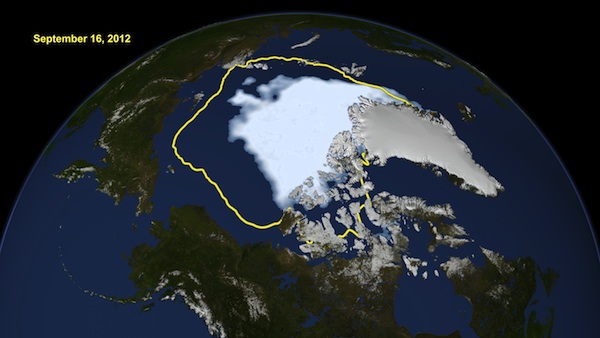Featured Stories, MIT, WHOI | November 26, 2012
Watching the Arctic Melt: Adventures in Polar Oceanography
by Genevieve Wanucha
One hundred people packed into the Whitehead Institute on November 19th to attend the Oceans at MIT special symposium, entitled ‘Watching the Arctic Melt: Adventures in Polar Oceanography.’ Most people there already knew that the Arctic Ocean’s ice cover goes through a cycle of seasonal growth and decline. Everyone had learned weeks ago that this sea ice hit a record minimum this fall. More surprising was the news that the Arctic, which has warmed twice the global average, may experience ice-free summers before 2050.

“This melting has enormous implications for shipping, fishing, Arctic ecology, oil and gas exploration, national security, and geopolitics,” said John Marshall, professor of oceanography at MIT, who kicked off the afternoon. “There is likely to be a ‘Gold Rush’ as the oil and gas resources in the Arctic become more available as it thaws.”
The event was a quintessential example of the close and longstanding collaboration between MIT and Woods Hole Oceanographic Institution, bringing together Arctic experts who are all pushing technical frontiers to study the high-stakes Arctic ice loss.
Their ultimate goal, as it soon became clear, is to be able to predict and model the behavior of the Arctic melting. However, that’s far from straightforward. As Patrick Heimbach, a principal research scientist in EAPS, emphasized, scientific prediction requires understanding—an understanding of, for instance, how ice sheets break apart and how ice interacts with the warming air above and water below. And understanding requires observation.
Fortunately, these speakers are bringing observation in the Arctic to the next level, especially John Toole, a senior scientist and chair of physical oceanography at WHOI who studies how the shrinking ice cap affects Arctic Ocean circulation. “Satellite data is useful, but it’s only skin deep,” he said as he took the stage. “It doesn’t give you information about the ocean interior.” So, he’s created tools to figure out what goes on below the ice.
Toole’s innovation, the “ice-tethered profiler,” is a buoy that sits atop the ice sheet, sending a wire down through the ice. A vehicle crawls up and down the wire, sending high-resolution data up to a satellite. His team has deployed 60 profilers since 2004 and will launch more next year. The huge amounts of data the profilers collect are allowing any researcher to track seasonal patterns in the Arctic ice extent through measures of salinity, oxygen, water velocity, and photosynthetic radiation.

Art Baggeroer and Henrik Schmidt, both professors at MIT’s Ocean Seismo-Acoustic Laboratory MIT, reported on their efforts to observe the Arctic using sound. By recording the sound and seismic waves traveling in the Arctic Ocean, they can infer exactly how and why the sea ice is breaking up.
Carin Ashjian, a senior scientist in the biology department at WHOI, uses a range of acoustic and video methods to study the surprisingly active ecosystem alive under the ice sheet. She’s spent days traveling aboard icebreakers in harsh weather to collect data on zooplankton, the preferred food of Arctic fish and whales, in hopes of modeling how temperature changes will lower their reproductive success. One big issue stands in her way.
“We don’t have a whole lot of long term records, and this makes it difficult to detect changes in the ecosystem,” she pointed out. “We need to continue our ongoing efforts to understand the natural variability of the Arctic so we can detect change.”
Admiral Richard Pittenger (Ret.), former leader of WHOI’s Marine Operations Division, suggested that the US Navy will be central to providing the infrastructure for this research effort, more for national security reasons than the ecosystem. It’s been a long road to acceptance of climate change within government institutions, but, he noted, “The Navy is one hundred percent on board. They know there are many strategic disadvantages if we aren’t preparing for the effects.”
Perhaps the most memorable moment of the afternoon came when WHOI’s Hanu Singh and MIT’s John Leonard revealed video of a robotic vehicle swimming through icy blue water, mapping the moving Arctic Ocean sea ice and floor. The audience now saw what scientists see in this footage: not beautiful, exciting images of adventure, but a glimpse at the first, slow steps in one of the most challenging research endeavors of our time.





